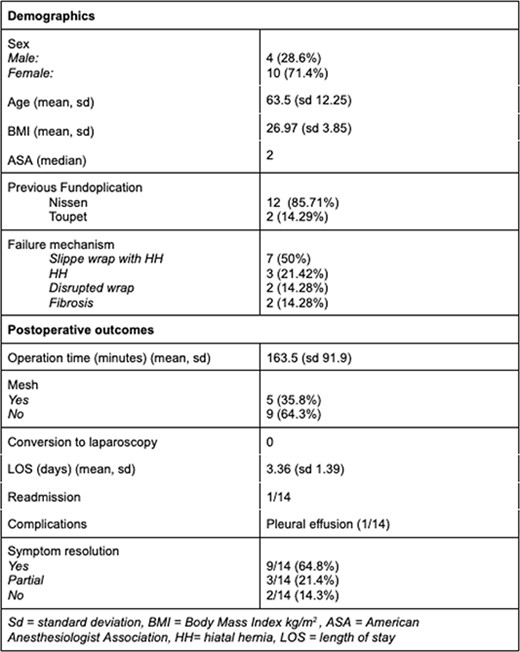-
PDF
- Split View
-
Views
-
Cite
Cite
Christian Jose Herrero Vicente, Arantxa Clavell Font, Ms Marta Viciano Martín, Elisenda Garsot Savall, 274. ROBOTIC REVISIONAL HIATAL HERNIA REPAIR (R-RHR): DOES IT MAKE SENSE?, Diseases of the Esophagus, Volume 37, Issue Supplement_1, September 2024, doae057.050, https://doi.org/10.1093/dote/doae057.050
Close - Share Icon Share
Abstract
The gastroesophageal reflux disease (GERD) is increasing among our population and Nissen Fundoplication still remains as the most widely performed technique. The robotic approach to the hiatal hernia repair has been proven to be safe and feasible.
Precision and comfort seem to be some reasons that it makes, at least, comparable to the laparoscopic approach.
Revisional hiatal hernia is a challenging situation to the operator due the adhesions and fibrosis of the tissues so our concern is that the best technology available is needed.
From June 2019 to November 2023 our division performed 14 cases of Robotic Revisional Hiatal Hernia Repair (R-RHR). Demographic items such as Gender, Age, Body Mass Index (BMI), Previous surgery, Time from first surgery and Postoperative outcomes as Operation Time, Length of stay (LOS), Mesh use, Complications and Readmissions were recorded.
10 women and 4 men were recruited. In all cases the DaVinci robotic platform X and Xi (Intuitive) was used. Mean age resulted in 63.5 years old (sd 12.25). Mean BMI was 26.97 (sd 3.52). In 71.4% cases the Previous HH Surgery was Nissen Fundoplication. 49.3 months was the mean time from the first surgery to the revisional procedure.
163.5 (sd 83.7) minutes was the mean operation time. Mean Lenght Of Stay resulted in 3.4 days (sd 1.4). There were no conversions to the laparoscopic approach. In 5 patients (35.8%) a mesh was placed.
Pleural effusion was the only postoperative complication reported (1/14) and it was managed non-operatively. No other complications were recorded and mortality rate was 0.
To the authors knowledge, this is Spain’s largest Robotic - Revisional Hiatal Hernia Repair (R- RHR) series. The results lead us to conclude that the robotic approach, even the complexity of the surgery, is safe and feasible in trained teams with similar outcomes from the primary surgery that are published.




